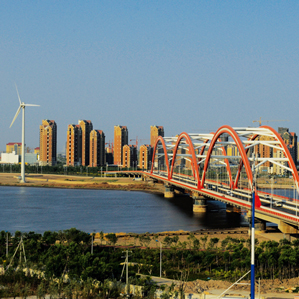China’s Future City
Strolling along sidewalks shaded by plane trees, one might take Tianjin Eco-City for just another of the many residential areas sprouting up all over China. But on closer inspection, this place is different. The roadside trash cans are covered with solar photovoltaic panels so they can light up at night; free electric buses connect different districts; the drainage wells for storm water are all embedded in the curbs.

There are less obvious features, too. The pavement is laid with pervious sand bricks for efficient drainage, and the water supply is designed to minimize leakage. Rainwater and wastewater are collected separately, and 18 submersible axial flow pumps capable of pumping 42.1 cubic meters of water per second divert the rainwater to artificial wetlands.
Here, on a piece of land about one-half the size of Manhattan, is one of China’s first attempts at sustainable urban development. It aims to address two of China’s most pressing challenges: the rapid population migration stressing the country’s already-large cities, and its growing pollution and environmental problems. The national government has praised the project as a success, but only 20,000 people have moved in, a fraction of the 350,000 the city is designed to house by 2020.
The Eco-City project, a collaboration of China and Singapore, is located on the eastern border of Tianjin, a manufacturing city of nearly 15 million people. Total investment has not been disclosed, but project officials say that as of 2012, 40 billion yuan ($6.5 billion) had been invested in fixed assets. Tianjin is one of four cities directly governed by China’s central government, and the Eco-City is located in its first “comprehensive reform and innovation area,” a designation associated with favorable investment and trade policies.
If it succeeds, Tianjin Eco-City would become a model. The country has 171 cities with populations over one million, and its total urban population is projected to rise to about one billion by 2030. By that time, close to 70 percent of China’s population will be living in urban areas. China’s cities can be difficult places to live. Beijing’s smog has become internationally famous. Water is an issue too. According to China’s Ministry of Environmental Protection, 57 percent of the groundwater in 198 cities tested in 2012 was rated either “bad” or “extremely bad.”
The goals set for the Eco-City include zero net loss of natural wetlands, a recycling rate of at least 60 percent, and a minimum of 12 square meters of public green space per capita. Six years after ground breaking, planners say they have achieved most of those goals, though Liu Xu, director of the ecological and environmental monitoring center at the Eco-City’s administrative committee, acknowledges “temporary deviations” from the standards set for ambient air quality, which he attributes to the impact of the surrounding environment.
The Eco-City’s small population is a worrisome sign, however, says Bao Cunkuan, a professor of environmental science and engineering at Fudan University. By building an eco-city from scratch, Bao says, “more often than not, we build a city that is disconnected from the reality and without the human element.”
Other than the lunch rush of Eco-City managers, the only crowds on the quiet streets form when parents pick up the 2,300 students at the area’s kindergartens and schools.
It was the schools, not the environmental programs, that convinced 38-year-old Fan Hongqin to move to the Eco-City a year ago. Her daughter is in second grade at a school with an emphasis on foreign languages. The city encourages enrollment by offering free school bus service, free meals, and monthly subsidies of 1,000 yuan ($163) for apartment-owning parents of kindergartners. “The environment here is more livable; that’s true,” said Fan, shortly after school pick-up one September afternoon. But the location is inconvenient. Even to buy clothes, Fan says, she must travel into other sections of Tianjin. The city center is an hour away.
The Eco-City is clearly a big environmental improvement from what sat on this land before: a one-square-mile wastewater reservoir. Containing mercury and DDT, it had lost all its ecological functions following years of heavy pollution by industry. Restoration cost one billion yuan ($163 million). “What used to be barren saline and alkaline wasteland has now been transformed into an emerging new green city,” says Ho Tong Yen, CEO of the Sino-Singapore Tianjin Eco-City Investment and Development Company. “We are not just a lofty plan but an actual, emerging city,” he adds. “We are for real.”
Keep Reading
Most Popular
Large language models can do jaw-dropping things. But nobody knows exactly why.
And that's a problem. Figuring it out is one of the biggest scientific puzzles of our time and a crucial step towards controlling more powerful future models.
The problem with plug-in hybrids? Their drivers.
Plug-in hybrids are often sold as a transition to EVs, but new data from Europe shows we’re still underestimating the emissions they produce.
Google DeepMind’s new generative model makes Super Mario–like games from scratch
Genie learns how to control games by watching hours and hours of video. It could help train next-gen robots too.
How scientists traced a mysterious covid case back to six toilets
When wastewater surveillance turns into a hunt for a single infected individual, the ethics get tricky.
Stay connected
Get the latest updates from
MIT Technology Review
Discover special offers, top stories, upcoming events, and more.